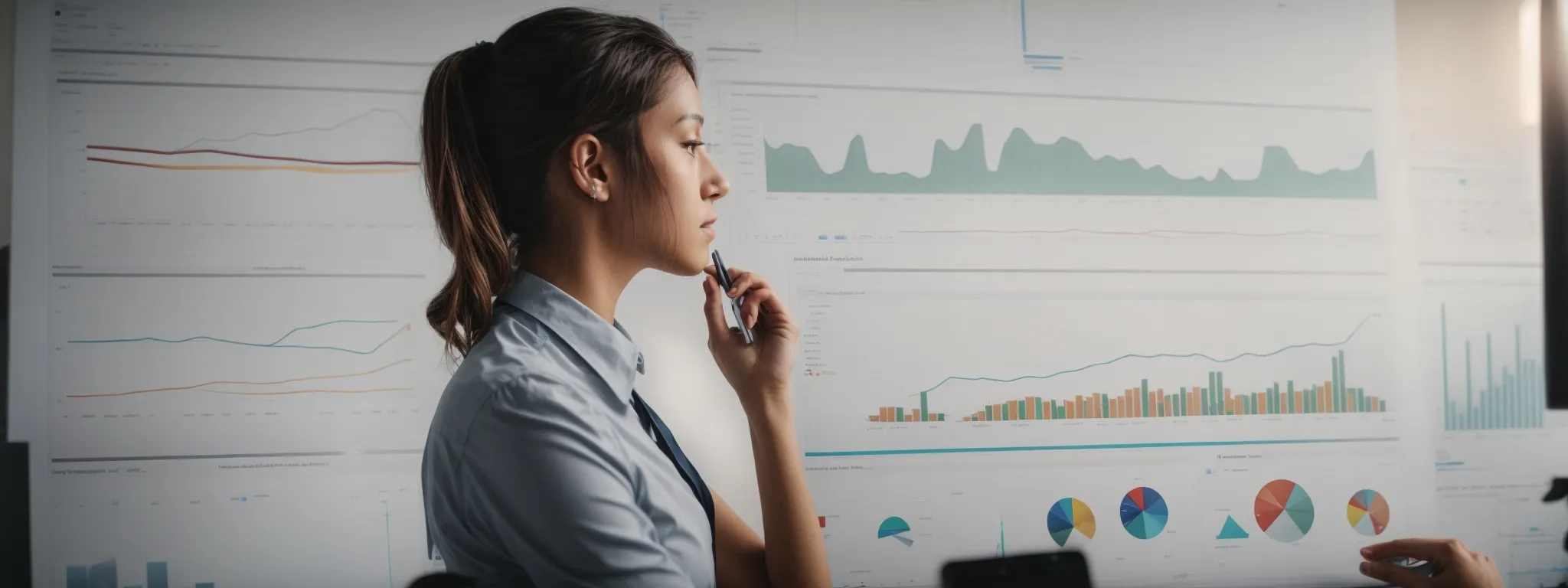Measuring Success: Key SEO Quality Indicators to Monitor
Tracking SEO Progress: Essential Quality Metrics for Success In the pursuit of mastering Search Engine Optimization, discerning which metrics indicate progress and success is paramount. Quality metrics […]
Tracking SEO Progress: Essential Quality Metrics for Success
In the pursuit of mastering Search Engine Optimization, discerning which metrics indicate progress and success is paramount.
Quality metrics offer a panoramic view of an SEO campaign’s effectiveness, from the organic swell of site traffic to the intricate dance of keyword rankings.
As companies, such as LinkGraph with its SEO services, provide tools like SearchAtlas SEO software, understanding and tracking these metrics becomes not only attainable but central to digital marketing strategies.
These data points illuminate the path to fine-tuning SEO efforts, ensuring every click and user interaction contributes to a business’s growth.
Keep reading to unlock the knowledge needed to measure, evaluate, and enhance your SEO performance with precision.
Key Takeaways
- SEO Strategies Must Align With Business Goals to Drive Meaningful User Engagement and Lead Generation
- LinkGraph’s SEO Services Provide Comprehensive Tools and Strategies for Improving Keyword Rankings and Organic Search Visibility
- A Robust Link Profile Is Crucial for SEO Success, With LinkGraph Offering Free Backlink Analysis to Optimize a Website’s Backlink Quality
- Behavioral Metrics Like Session Duration and Bounce Rate Are Key Indicators of Content Relevance and User Satisfaction, Shaping SEO Strategies
- Core Web Vitals Are Critical to SEO Rankings, and LinkGraph Provides Optimization Strategies to Meet These Technical Performance Benchmarks
Understanding SEO Progress Through Quality Metrics

Embarking on the journey of optimizing a website for better search engine visibility is synonymous with tracking an array of quality metrics that reflect the effectiveness of an SEO strategy.
It is imperative that businesses not only pinpoint the key performance indicators (KPIs) that offer a clear view into their SEO activities but also ensure these are in harmony with broader business objectives.
A nuanced approach to evaluating SEO performance necessitates an alignment between the meticulous analysis of data-driven SEO metrics and the overarching ambitions of the enterprise.
This foundational understanding prepares organizations to refine their marketing efforts for measurable improvements in search engine results and, ultimately, business growth.
Identifying Key Metrics in SEO Strategy
When charting the course of an SEO campaign, LinkGraph’s SEO services emphasize the importance of distilling the myriad of available data into actionable insights. A primary focus is placed on KPI metrics such as keyword rankings, organic search traffic, and conversion rate, indicators that paint a vivid picture of SEO ROI.
These core metrics serve as a GPS for businesses navigating the complex landscape of digital marketing, with expert SEO strategists at LinkGraph ensuring aligning these indicators with the specific goals and aspirations of the client. Through white-label SEO services, transformations in search visibility and user engagement become not only observable but also tangible levers for increased site traffic and business success.
Aligning Business Goals With SEO Objectives
To attain success in search engine optimization, LinkGraph’s SEO services stress the value of synchronizing SEO goals with business goals. Meticulously aligning these objectives streamlines the route toward meaningful user engagement and leads generation, turning site visitors into valued customers.
For companies to thrive in the digital ecosystem, the fusion of product development, customer experience, and technical SEO becomes essential. LinkGraph tailors SEO strategies to complement a client’s unique business aspirations, leveraging refined keyword research and content optimization to target the right audience effectively.
| SEO Objective | Business Goal | LinkGraph Strategy |
|---|---|---|
| Boost Organic Search Visibility | Increase Market Share | Comprehensive Keyword Research |
| Improve User Engagement | Enhance Brand Loyalty | Optimized Content Marketing Strategy |
| Expand Quality Backlink Profile | Grow Business Authority | Targeted White-label Link Building |
The Significance of Organic Traffic Growth

Organic traffic stands as a cornerstone of a successful SEO strategy, indicative of the resonance and relevance a website holds in the digital realm.
The influx of visitors arriving through search engines serves as a testament to optimized site content, reflecting a natural alignment with the queries and needs of users.
As businesses seek to analyze and bolster this form of site traffic, sophisticated tools like LinkGraph’s SearchAtlas SEO software become indispensable.
These tools empower marketers to dissect and comprehend the nuances of traffic sources, enabling them to fine-tune their digital marketing strategies for enhanced search visibility and user acquisition.
What Constitutes Organic Traffic
Organic traffic encapsulates those visitors who land on a website due to the site’s ranking in the search engine results page (SERP), rather than through paid advertising or direct navigation. It is the product of user searches that naturally lead to a website, reflecting the efficacy of its SEO content strategy.
The quality of organic traffic can be ascertained through a free SEO audit, which scrutinizes the relevancy and search intent of the visitor’s queries. LinkGraph’s SEO services equip businesses with the knowledge to curate content that aligns with their audience’s needs, fostering a rich vein of high-intent organic traffic:
| Organic Traffic Source | User Intent | Resulting Action |
|---|---|---|
| Keyword Search | Informational | Page Visit |
| Local Search | Transactional | Store Locator Click |
| Organic Backlink | Navigational | Referral Visit |
Tools for Analyzing Traffic Sources
For businesses to effectively decipher the intricacies of their website traffic, utilizing sophisticated analytical tools is pivotal. LinkGraph’s SearchAtlas SEO software rises to the occasion, delivering an incisive suite of features for in-depth traffic source analysis and insightful reporting.
The precise measurements these tools offer allow marketers to identify which channels are contributing to site traffic and how users interact with the site effectively: Knowing the origins of traffic helps businesses to optimize their pages for search impressions and enhance their overall SEO campaign:
- Analyze search query specifics to target user search behavior.
- Monitor visitor session duration to gauge content engagement quality.
- Evaluate the backlink analytics to recognize areas for improvement in link-building efforts.
Breaking Down the Importance of Keyword Rankings

In the realm of search engine optimization, keyword rankings stand as a cardinal metric, indicative of a website’s prominence and traction in search results.
These rankings serve as a barometer for gauging the visibility of a website in relation to specific search terms and are profoundly influenced by a spectrum of factors ranging from on-page content quality to backlink profiles.
By harnessing the analytical power of rank tracking tools, brands can glean strategic insights that can pivot their marketing efforts towards enhanced search engine presence and improved audience targeting.
LinkGraph’s SEO services excel in offering businesses the expertise to navigate these indicators effectively, ensuring that fluctuations in keyword performance translate into informed strategy adaptations.
Factors Influencing Keyword Performance
The landscape of keyword rankings is largely shaped by the frequency and authority of a website’s content updates. LinkGraph’s on-page SEO services play a critical role, enhancing the relevance and specificity of content to match targeted search queries, thus influencing the site’s search position directly.
Another pivotal factor resides in the architecture and health of a website’s backlink profile. The development and nourishment of authoritative external links through white-label link building services signal to search engines the credence and value of the linked content, thereby lifting keyword rankings:
- Meticulous on-page content optimization for targeting search queries.
- Strategic backlink acquisition to boost site authority and relevance.
- Persistent monitoring and refining of keyword performance indicators.
Utilizing Rank Tracking for Strategic Insights
Unlocking the potential of rank tracking is fundamental for understanding the dynamics of search visibility. LinkGraph’s SEO services incorporate cutting-edge tools that not only reveal fluctuations in keyword standings but also offer predictive insights, empowering clients to anticipate market trends and adjust their SEO strategies accordingly.
These strategic insights allow for a granular examination of how individual pages are performing in the search engine results pages (SERPs). By continuously tracking this data, LinkGraph enables clients to pivot their content and optimization tactics, ensuring that their website remains competitive and visible to their target audience.
| Keyword | Current Rank | Previous Rank | Visibility Trend |
|---|---|---|---|
| Best Digital Marketing Strategies | 3 | 5 | Improving |
| Local SEO Services | 8 | 11 | Improving |
| Organic Link Building Techniques | 12 | 9 | Declining |
Measuring SEO Success With Conversion Rates

Within the multifaceted discipline of SEO, conversion rate is a crucial metric that reflects the efficacy of a business’s online presence in achieving specific outcomes beyond just attracting visitors.
This metric translates the amalgam of SEO efforts into tangible results, illustrating the journey from initial search to completed goal whether that is a purchase, a sign-up, or an inquiry.
Insightful analysis of conversion paths and accurate attribution helps businesses fine-tune their strategies to ensure that search engine optimization translates into optimal performance across the entire marketing funnel.
Defining Conversions in an SEO Context
In the realm of Search Engine Optimization, the term ‘conversion’ represents a vital benchmark – it is the culminating point where a visitor’s interaction aligns with the business’s intended outcome. This end goal may manifest in various forms, such as a product purchase, a newsletter signup, or scheduling a consultation – each acting as a clear indicator of an SEO campaign’s ability to influence user behavior.
LinkGraph’s SEO services are keenly focused on optimizing for conversions by honing in on user experience and facilitating a seamless journey from search query to desired action. The measure of success lies within the ability to convert organic traffic into business objectives, positioning conversions as both the endgame and the ultimate barometer of SEO efficacy:
- Examining web page design and calls-to-action to heighten user engagement
- Deploying targeted content marketing to capture and convert high-intent visitors
- Using performance data to refine strategy, ensuring alignment with user needs and business goals
Analyzing Conversion Paths and Attribution
Analyzing conversion paths enables LinkGraph’s clients to trace the user’s journey from the initial search query to the final conversion point, offering invaluable insights for enhancing the efficacy of SEO campaigns. Attribution modeling, a cornerstone of LinkGraph’s SEO services, provides clarity on which touchpoints and channels wield the most influence on the customer’s decision-making process, thereby allowing for optimized allocation of resources and efforts.
Through meticulous conversion path analysis, businesses can discern the nuanced interaction between various digital marketing activities and their cumulative effect on conversion rates. LinkGraph ensures that this analysis informs SEO strategies, leading to sophisticated adjustments in content and user experience elements that align closely with the intent behind user searches and ultimately drive conversion performance.
Analyzing Backlink Profiles for SEO Health

In the intricate tapestry of Search Engine Optimization, backlinks emerge as silent yet potent conduits of credibility and authority.
These digital endorsements, linking one site to another, play a pivotal role in fortifying a website’s stature within search engine algorithms.
Recognizing their significance, the assessment and refinement of backlink quality become paramount for businesses striving for SEO excellence.
Gleaning insights from a comprehensive backlink analysis does more than illuminate the network of connections—it feeds into the strategic manipulation of these elements to bolster overall SEO health.
The Role of Backlinks in SEO
In the digital ecosystem where search engines reign supreme, backlinks are akin to votes of confidence, signaling the relevance and authority of a website’s content. The accumulation of quality backlinks from reputable sites not only endorses the credibility of a web page but also enhances its potential to climb the rank ladder on the search engine results page.
Fostering a robust link profile constitutes a staple of LinkGraph’s SEO services, understanding that backlinks are not just connectors but drivers of SEO success. A Meticulously Curated Backlink Portfolio reverberates through search engine algorithms, translating into visibility and search prominence:
| Backlink Attribute | SEO Impact | LinkGraph Strategy |
|---|---|---|
| Relevancy | Enhances Topic Authority | Concentrated Content Matchmaking |
| Authority of Link Source | Boosts Domain Trust | Strategic High-Domain Partnerships |
| Anchor Text | Improves Relevance for Target Keywords | Optimized Anchor Text Curation |
Auditing and Assessing Your Backlink Quality
An audit of backlink quality serves as a critical examination, pinpointing both strengths and potential vulnerabilities within a website’s existing link profile. LinkGraph’s SEO services proffer an invaluable analysis, highlighting the impact each backlink has on the site’s search engine standings: it demystifies the complex interplay between quantity and quality.
Assessing the caliber of backlinks involves a careful review of their relevancy, the domain authority they carry, and the context within which they exist. LinkGraph’s free backlink analysis empowers clients by providing a clear snapshot of their backlink’s effectiveness, thereby enabling strategic enhancements:
- Evaluation of link relevancy to ensure connections between complementary content
- Analysis of domain authority to measure the weight each backlink contributes
- Scrutiny of link context for alignment with the site’s content and user search intent
Evaluating Content Performance With Engagement Metrics

In the sophisticated endeavor of search engine optimization, measuring the impact of content through engagement metrics provides a window into the resonance of a website’s offerings with its audience.
These metrics, which include factors like session duration, bounce rates, and user interactions, are instrumental for businesses in assessing content relevance and user satisfaction.
For those seeking to refine their digital footprint, keeping a watchful eye on these critical indicators offers a pathway to enhance content strategies and foster enduring user engagement.
LinkGraph’s adept use of analytics extends beyond surface-level statistics, delving deeply into data to support continuous improvement of content architecture and strategy alignment with audience needs.
Key Engagement Indicators to Watch
The journey of content optimization is keenly monitored by LinkGraph’s SEO services, where session duration stands as a revered indicator of content’s captivation ability. When users linger, engagement heightens, a sign that the material is hitting the mark with the intended audience, fulfilling their search intentions, and delivering value.
Bounce rate offers another prism through which user satisfaction can be assessed, unraveling the story behind visitor retention or departure. LinkGraph harnesses this metric, interpreting the interplay between content presentation and user behavior, to ensure a website’s offerings align seamlessly with searcher expectations and interests.
Using Analytics to Improve Content Strategies
LinkGraph’s SEO services employ the precision of analytics to continuously sharpen content strategies, bridging the gap between data interpretation and practical application. By extracting insights from user behavior metrics, these services empower clients to adapt their content in real-time, optimizing for the ever-evolving preferences of their target audience.
The application of advanced analytical tools, such as the comprehensive SearchAtlas SEO software, enables the dissection of complex engagement data, translating it into actionable refinements for content creation. This approach ensures that each piece of content is crafted with precision, effectively meeting the informational demands of the searcher and supporting sustained SEO success.
Importance of Page Load Speed in User Experience

In the competitive sphere of digital marketing, the vehemence of page load speed can significantly influence a site’s user experience and its subsequent SEO rankings.
As a critical element of technical SEO, the quickness with which a website becomes interactive is not merely a convenience for users, but a deciding factor in search engine algorithms that determine a site’s prominence in search results.
Employing advanced tools to monitor and enhance site speed is thus fundamental for businesses that aim to uphold exceptional user experiences and secure a prime position within the rankings of search engine results pages (SERPs).
Impact of Speed on SEO and Ranking
In today’s fast-paced digital landscape, page load speed emerges as a critical influence on a website’s SEO and ranking. A swift load time enhances user experience, consequently signaling to search engines the site’s usability and reliability: factors that are weighted within their ranking algorithms.
- Quick page responsiveness meets user expectations, reducing bounce rates associated with impatience.
- Enhanced speed correlates with higher user satisfaction, increasing the likelihood of conversions and repeat visits.
- Search engines prioritize site speed in their metrics, rewarding faster sites with better visibility in search results.
Moreover, as mobile browsing continues to dominate internet usage, speed becomes even more pivotal to SEO ranking. Google’s mobile-first indexing underscores the necessity for optimized page speed across all devices, directly impacting a site’s position in the crowded search results landscape.
Tools for Monitoring and Enhancing Site Speed
In the pursuit of refining page load speed, LinkGraph’s SEO services incorporate advanced diagnostic tools that meticulously audit and monitor website performance. These tools are engineered to identify bottlenecks impacting speed, offering precise recommendations for optimization and enabling swift remedial action.
Adhering to the best practices for enhancing page speed, LinkGraph ensures that each tweak and adjustment to a website’s technical infrastructure is grounded in solid data. Through real-time monitoring and automated speed testing, clients are able to enact strategies that keep their digital properties agile and responsive across various devices and platforms:
- Utilization of progressive web app technologies for faster load times and app-like experiences on mobile devices.
- Implementation of content delivery networks (CDNs) to distribute and cache content closer to users, reducing latency.
- Optimization of images and code to strip unnecessary bulk without compromising on quality or functionality.
Leveraging Click-Through Rate to Gauge Interest

Click-Through Rate (CTR) stands as a critical indicator of a website’s appeal and relevance in the eyes of its target audience, serving as a direct reflection of the efficacy of a website’s title tags and meta descriptions as they appear on the Search Engine Results Page (SERP).
In the pursuit of SEO success, understanding and optimizing for CTR is non-negotiable.
It reveals how well a site captures user attention against competing results and is a telling sign of whether the content resonates with the searcher’s intent.
As businesses engage LinkGraph’s SEO services for bolstering their digital presence, strategizing to enhance SERP CTR emerges as a central aspect.
It requires a detailed exploration of potent tactics that not only improve visibility but also entice searchers to choose their site over others.
Understanding Click-Through Rate Significance
Click-Through Rate (CTR) is a paramount metric for assessing how well a website’s search snippet drives user action. As a percentage, it represents the frequency with which searchers click on a site’s link after viewing it in the search results, making it a direct measure of initial user interest and the effectiveness of a page’s title and description in capturing attention.
Improving CTR is crucial for search engine success and often requires crafting compelling meta descriptions and titles that resonate with the target audience’s search intent. The optimization of these elements:
- Directly affects a website’s ability to attract clicks from SERPs, impacting traffic and potential revenue.
- Signals the relevance and value of content to search engines, contributing to overall SEO performance.
- Enhances the probability of increasing search rank, as higher CTR can indicate superior content match to user queries.
Strategies to Improve Your SERP CTR
Enhancing a website’s SERP CTR necessitates a strategic approach that begins with a deep understanding of the target audience’s needs and search behavior. LinkGraph’s SEO services Craft Metadata With Precision, ensuring descriptions and titles are not only enticing but also reflective of the content’s core message.
- Creating descriptive and actionable title tags that incorporate main keywords
- Designing compelling meta descriptions that offer a clear value proposition
- Testing different calls-to-action to determine which resonates best with the target audience
Testing and optimization play pivotal roles in improving SERP CTR. LinkGraph harnesses A/B testing methods to iteratively refine titles and metadata, analyzing the data to identify which variations drive the highest click-through rates and user engagement.
Insights From Bounce Rate and User Behavior

Within the intricate web of search engine optimization metrics, bounce rate and user behavior emerge as pivotal constructs for assessing the alignment between a website’s content and the interests of its visitors.
As businesses delve deeper into the analytical aspects of their SEO audits, these behavioral metrics serve as a compass, guiding improvements in user experience and page optimization.
Interpreting bounce rate intricacies, along with a comprehensive understanding of user interaction, is essential for crafting an SEO roadmap that fosters heightened engagement and positions a website favorably in the eyes of both users and search engines alike.
Interpreting Bounce Rate in an SEO Audit
Within the landscape of search engine optimization, a meticulous comprehension of bounce rate during an SEO audit can offer profound insights into user engagement and content relevance. As LinkGraph’s SEO services analyze this metric, they recognize it as an indicator of how compelling and pertinent the website is to its audience, affecting both session duration and the likelihood of fulfilling desired user actions.
An SEO audit that scrutinizes bounce rates sheds light on potential disconnects between a website’s offerings and user expectations, prompting strategic enhancements in content and user experience design. In its commitment to client success, LinkGraph leverages these insights to refine on-page elements, thus optimizing a website’s allure to not just attract, but also to retain and convert site visitors into engaged customers.
Behavioral Metrics and Their Effect on SEO
Behavioral metrics such as pageviews, time on site, and interactions per visit offer invaluable insights into the success of SEO efforts. These user-centric indicators underscore the significance of content alignment and engagement, which are essential for not only capturing but also sustaining the interest of site visitors.
Accurately interpreting these metrics allows businesses, with the guidance of LinkGraph’s SEO services, to adapt their online strategies swiftly and effectively. The data lays the groundwork for improving website elements that drive SEO performance by fostering positive user experiences:
- Enhancement of user interface and navigation structures for intuitive browsing and reduced friction points.
- Content refinement to provide clear, valuable, and action-inducing information that resonates with the audience.
- Ongoing analysis of interaction patterns to continuously develop and evolve SEO strategies that cater to user preferences and behavior.
The Role of Core Web Vitals in SEO Ranking

In the dynamic landscape of search engine optimization, Core Web Vitals have emerged as pivotal components defining the usability and quality of user experience on a website.
These vitals comprise a set of specific factors that Google considers important in a webpage’s overall user experience, playing a significant role in influencing SEO rankings.
Vigorous tracking and enhancement of Core Web Vitals scores have become essential tasks for digital marketers and SEO specialists who aim to adhere to the latest algorithmic preferences of search engines.
In this section, we delve into the intricacies of Core Web Vitals and their profound implications for SEO, providing insights on how businesses can measure and optimize these critical scores for improved search performance.
Explaining Core Web Vitals and SEO Implications
Core Web Vitals stand as Google’s chosen subset of factors dedicated to understanding user experience, signifying their critical influence on SEO ranking. They embody the essence of a site’s functionality, evaluative by such aspects as loading time, interactivity, and the stability of content as it loads, factors which collectively paint the picture of a seamless and user-centric online presence.
Businesses attentive to these SEO implications align their web performance with the expectations set forth by search engines, ensuring their pages meet high standards for a positive user experience. It’s this adherence to Core Web Vitals that now informs search ranking, placing a premium on optimizing technical details that enhance how users engage with a site and how those interactions affect visibility in search results.
Tracking and Improving Core Web Vitals Scores
Refined monitoring of Core Web Vitals scores is indispensable for SEO strategists who are intent on enhancing the user experience metrics that Google values. LinkGraph’s SEO services provide the expertise to dissect these scores, offering clear directives for improvements in performance, interactivity, and visual stability.
Analyzing the Core Web Vitals involves a deep dive into load times, the first input delay, and Cumulative Layout Shift, using them as benchmarks to prioritize web development efforts. With LinkGraph’s continuous assessment and optimization guidance, clients can maintain an agile approach to web performance:
| Core Web Vital | Exemplary Benchmark | LinkGraph Strategy for Optimization |
|---|---|---|
| Largest Contentful Paint (LCP) | 2.5 seconds or faster | Optimizing server response times and asset loading |
| First Input Delay (FID) | 100 milliseconds or less | Minimizing or deferring JavaScript execution |
| Cumulative Layout Shift (CLS) | 0.1 or less | Ensuring visual element stability post-load |
Conclusion
In conclusion, tracking essential quality metrics is fundamental for evaluating and steering the success of SEO strategies.
Metrics such as keyword rankings, organic traffic, conversion rates, and backlink profiles are paramount for understanding the impact of SEO efforts.
Adhering to these indicators allows businesses to align SEO goals with business objectives, thereby optimizing user experience, content relevance, and overall website performance.
By employing sophisticated analytical tools and methodologies, like those provided by LinkGraph, companies can gain actionable insights and fine-tune their online presence, which results in better search rankings, targeted user engagement, and, ultimately, business growth.
Emphasizing page load speed, click-through rates, and Core Web Vitals further refines user experience, contributing significantly to a website’s search engine ranking and online authority.














































































